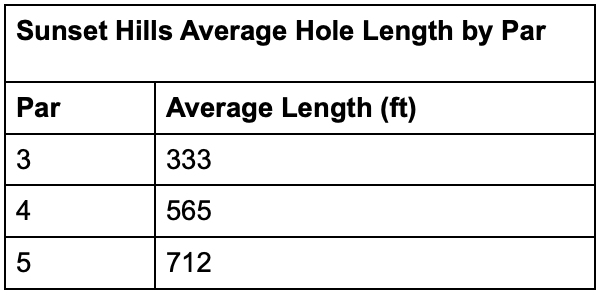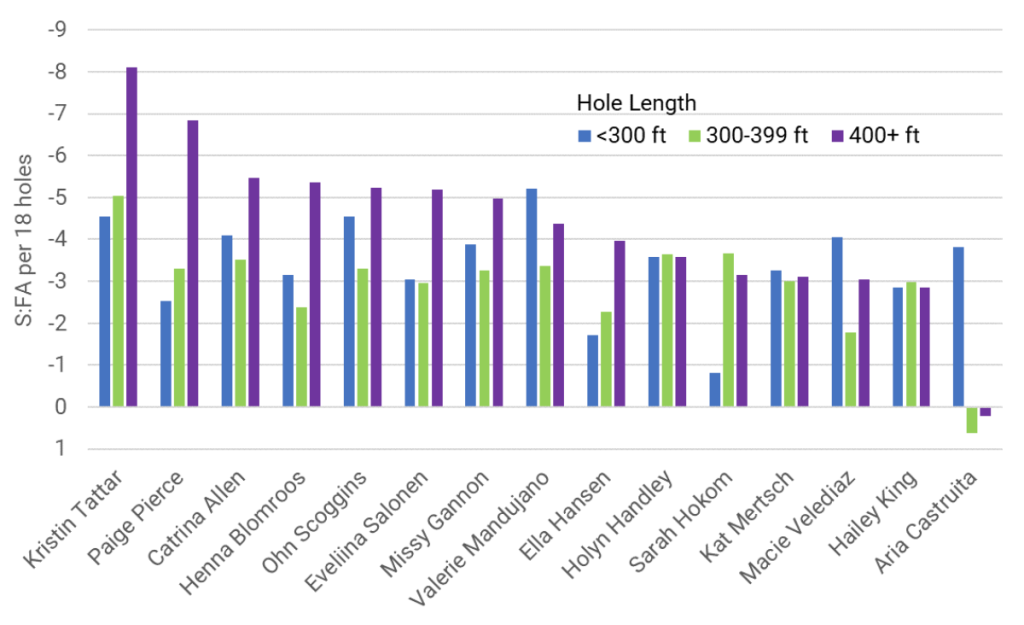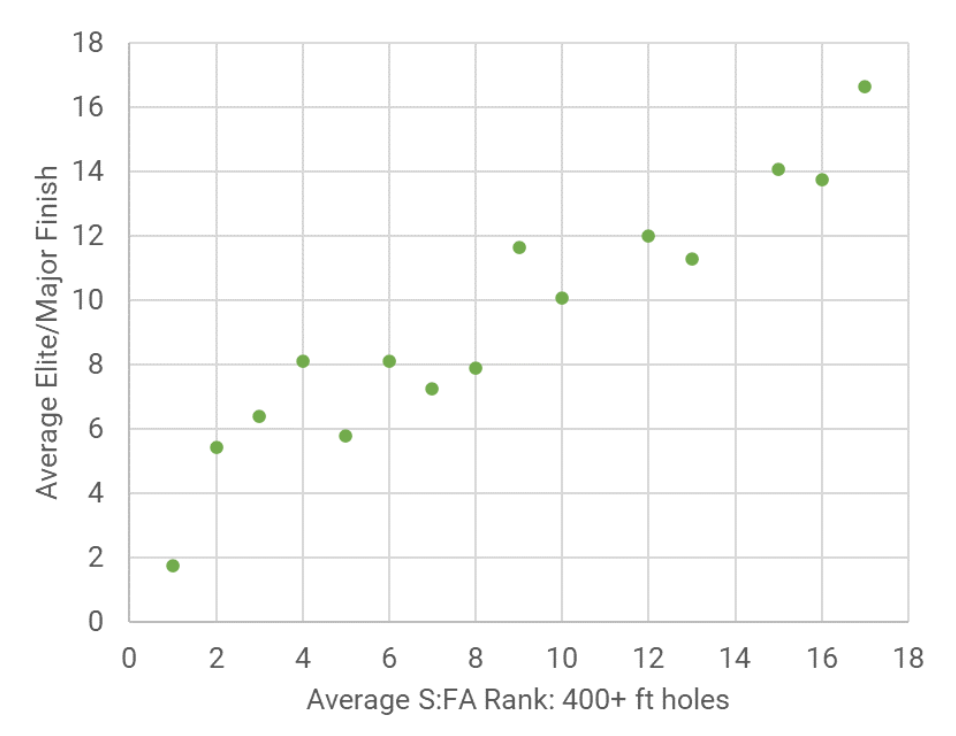Originally published at: https://discgolf.ultiworld.com/2023/01/26/its-time-for-more-thoughtful-fpo-course-design-on-tour/
2022 was the most exciting season of FPO disc golf in recent memory. Kristin Tattar became the first person other than Paige Pierce or Catrina Allen to hold the number one spot in the Statmando Official Rankings since the end of the 2012 season, earning over $100,000 in prize money in the process. The growing strength and depth of the field showed as new records were set for the number of unique winners (7), unique podium finishers (18), and average field size (50) at Elite and Major events. With so much hype and attention around the FPO game, now is the time to address a significant issue: FPO course design.
One simple stat can set the stage for this problem: in 2022, there were a total of three holes at Elite events that went an entire round without being birdied by the MPO field (WACO R2 H15, Texas States R1 H4, DDO R4 Emporia Country Club H4). In FPO, the number of holes not birdied in a round: 68.
Traditionally, disc golf courses have been designed by men for MPO fields with FPO fields stuck on the same layouts. As the professionalism of the sport has progressed in recent years, more events have added FPO tee pads or baskets, and one event (Ledgestone, with Sunset Hills) has a dedicated FPO course. However, only 50% of the holes at 2022 Elite events had dedicated FPO tee pads or baskets. Putting the FPO field on MPO layouts, regardless of par, leads to holes that lack score separation and spectator appeal. In this article, we will examine the best and worst of FPO course design in 2022 and what the numbers can tell us about the future of FPO courses.
Stop putting the FPO field on MPO layouts
While the trend is decreasing, two events in 2022 still put FPO players on MPO layouts: Las Vegas Challenge (LVC) and European Open. In the modern era, this outdated approach is an unacceptable disservice to the field.
The largest challenge FPO competitors face on MPO courses is distance. At LVC, there were nine par 3s that measured in at over 400 feet. These nine holes yielded just nine birdies total, seven of which came in two holes that play downhill (R1 Infinite Course Hole 12 and R3 Factory Course Hole 1). Five of the nine holes had zero competitors reach C1 in regulation (C1R). Conversely, nine par 4s were under 450 feet and gave up 252 birdies or better. Hole 13 in Round 4 had 100% of players reaching C1R, with only three players not getting birdie or better due to missed putts.
From a scoring and play perspective, LVC is still eclipsed by the European Open as the worst FPO course on tour. There were 27 holes (of 72) with no birdies carded, and another 18 holes with just a single birdie. Only 7 holes played below par. Players averaged 1.3 birdies per round, and almost 8 bogeys or worse per round, the worst for both stats on the season. There is no justifiable reason for this FPO layout to be on tour, let alone at a Major. This course needs a new FPO layout, and not just an adjustment in par from the MPO tees.
At LVC, the FPO par was higher than MPO by 8 strokes, 7 strokes, and 4 strokes on the Innova, Factory, and Infinite courses, respectively. The issue with these courses is not the par–increasing or decreasing par does not change the difficulty of a hole. Hole 11 on the Infinite course (R1) was the only hole to play under par in 2021, so par was changed from 4 to 3 for 2022. In 2021, the hole averaged 3.41; in 2022, it averaged 3.38. Clearly, changing the par did not change the difficulty of the hole or the final number of strokes on the scorecard.
Texas States provided another perfect example of how simply changing the par is an inadequate solution. FPO and MPO played from the same tee pad to the same basket for hole 11, coming in at 485 feet. This hole was a par 3 for MPO and a par 4 for FPO. Across all 3 rounds, fewer than 5% of the FPO field got a bogey on this hole, with 0 bogies in round 3. 64% of the field was under par on this hole during the first round, and that percentage only increased across rounds, while essentially the remainder of the field took a par. Regardless of whether the par had been 3 instead of 4, this hole typified a poor FPO design that lacked any scoring separation.
Acclaimed course designers John Houck and Leonard Muise describe on the Roots of Flight podcast how holes that are not an appropriate distance (for either division) result in NAGS (Not A Golf Shot). If a competitor in either division ends up 80-100 ft from the pin, they are very unlikely to make their next shot, but very likely to get up and down in two shots. This creates a lack of scoring separation and illustrates why changing the par doesn’t fix the problem with the hole.
The easiest solution to addressing distance is adding thoughtfully designed FPO tee pads or pin placements with the appropriate distances to baskets or landing zones to make every shot a golf shot. Looking at WACO hole 2, the MPO field had to make a 400-450 drive to get a 180-230 ft putter/midrange upshot. By using a tee pad that is 100 ft shorter, the FPO field had to make a 300-350 ft drive to have a similar 180-230 ft putter/midrange upshot. Over three rounds, the MPO averaged 3.72 strokes, while the FPO field averaged 3.71. Meanwhile, holes like 5, 6, 8, and 14 provide challenge and score separation for both divisions and can use the same tee pads and basket locations. Every course must be designed with the FPO division in mind, with thoughtful placement of tee pads and baskets to challenge the field appropriately.
Make better, not just shorter, courses
Sunset Hills (Ledgestone) is the only dedicated FPO course on tour. Outside of the USWDGC courses, Sunset Hills had the lowest over par percentage at 20.67% and the second highest under par percentage at 23.4%. The course was also the site of the only FPO albatross on tour, thrown in by Holyn Handley. The course is one of the more balanced on tour, with only one more right-to-left shaped fairway than left-to-right. And while Sunset Hills was the 4th-shortest course in 2022 at 7,539 ft, it’s hard to argue that the course is too short given the following average hole lengths:

Sunset Hills contrasts sharply with Idlewild, which has a remarkably similar breakdown of average hole length by par.

For holes of par 3 and 4, Idlewild actually has a shorter average hole length. However, because Idlewild is more of a wooded track than Sunset Hills, it played significantly differently in the aggregate. At Sunset Hills, there were zero holes where more than 50% of the field took a bogey or worse. At Idlewild, there were 20 holes where more than 50% of the field took a bogey or worse. Of course, there were weather considerations at Idlewild this year as well, but rain alone cannot explain this type of discrepancy. Besides pure distance, designers need to consider shot shaping and terrain when developing FPO layouts. The terrain and the rough at Idlewild often call for more standstill shots, which can impact both the distance and the angle players can achieve, while the open course nature of Sunset Hills provides players with the opportunity to use a run-up or have an uninhibited shot swing in most cases.
A key difference with Sunset Hills is that it was not designed as a MPO championship level course, with an FPO layout added later. It was tailored specifically for FPO, and FPO performance on this course reflects that consideration. More events need to design courses and layouts specifically for the FPO.
The shortest courses
The only two courses under 7,000 feet in 2022, Elver and Token Creek at USWDGC, were criticized by some — including top level touring pros — as being too short for the FPO field. However, of 26 FPO courses on tour, Token Creek was the only one to average below par. Meanwhile, 19 MPO courses played below par, with only 7 MPO courses playing above par. Across the two courses, the field over par percentage of 18% was the lowest on tour. More scoring and fewer bogeys made for an exciting event with an electric finish. It also allowed us to see different names on the leaderboard as the courses challenged different skill sets than the standard tour courses. As a specific example, when more players can reach circle 1 in regulation, high putting percentages play a greater role in overall success on the course. At USWDGC, the podium averaged 82.3% C1X and 33% C2 putting, while the podium at European Open averaged 71.3% C1X and 12.3% C2 putting.
To examine how players perform on holes with different characteristics, StatMando developed a metric called Strokes to Field Average (S:FA, pronounced ‘sofa’). These characteristics can include fairway shape, hole length, elevated baskets, etc. The number of strokes gained compared to the field average by hole length is shown below for players in the top 10 in any category. Values that are negative are good as they represent a lower round score.
The below table shows the rank of how players performed on holes of different lengths in 2022, with only players in the top 10 of any category shown:
[table id=247 /]
For holes under 300 feet, Valerie Mandujano gained 4.38 strokes per round on average on the field. It is not surprising, then, to see her finish in 2nd at the shortest courses on tour, or to have Scoggins and Allen — 3rd and 4th on holes under 300 feet — finish in 3rd and 4th, respectively.
The 6 players who were top 10 in each hole length accounted for 10 Elite/Major wins in 2022. Notably, Kristin Tattar was 2nd under 300 ft and 1st in both categories above 300 ft. Meanwhile, Paige Pierce, 2nd in 400+ ft holes, was 7th in 300-399 ft holes and 14th under 300 ft, gaining just 2.5 strokes per round on the shortest holes on tour. While 400+ ft holes account for just over half of the FPO holes on tour, comparing the rank of average S:FA by 400+ ft holes to average Elite/Major finish, it becomes clear what skills are the most highly valued to finish well at these events:
FPO ranking of average strokes to field average (Average S:FA) for 400+ ft holes and average 2022 Elite/Major finish.What’s next for FPO layouts?
The data show us that the era of putting the FPO field on MPO layouts needs to end. Courses need to be balanced to provide players a variety of challenges in distance and shot shape. The easy solution: hire FPO course designers or consultants to review FPO layouts. Design courses and layouts for FPO players; don’t just modify MPO courses for FPO play.
It’s not a coincidence that the courses highlighted in this article were Sunset Hills, Elver, and Token Creek – these three courses were the only ones seen on tour that were designed specifically for FPO. They provided good scoring separation and gave FPO players numerous opportunities to score, allowing for competitive and exciting rounds to watch. Other courses on tour, of course, have excellent individual holes, but the time has come to raise the bar and push for better courses in the aggregate. The DGPT and PDGA can further this goal by reviewing course layouts well in advance of events and providing feedback to local tournament directors and organizers.
To support the growth of the FPO game, the field deserves courses designed to challenge them appropriately, allowing players to hone their skills and fans to enjoy the competition.


